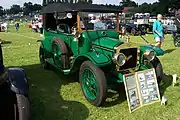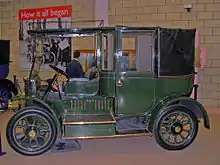| Austin 15-h.p. | |
|---|---|
.jpg.webp) 1911 chassis with special tourer body chassis 4043, engine 6186 | |
| Overview | |
| Manufacturer | Austin |
| Production | 1908 - 1915 |
| Powertrain | |
| Engine |
|
| Transmission | 4-speed |
The Austin 15 hp is a 2.8-litre motor car manufactured by the British manufacturer Austin and first displayed at the seventh exhibition of motor vehicles which opened at London's Olympia in November 1908. Its tax rating was 20 horsepower. It was sold between 1908 and 1915.
Olympia Motor Show 1908
It was at this show it first became clear British manufacturers now recognised the need to provide medium-sized cars. A host of new models in the 14 to 16 hp class were displayed. Just twelve months later it was believed only Rolls-Royce made solely high-powered cars.[1]
Monobloc engine
The first version, of which 213 were produced, was sold between 1908 and 1910.[2] It was powered by a 4-cylinder 2½-litre (2539 cc) monobloc engine with a 3.5-inch (89 mm) bore x 4-inch (100 mm) stroke and a three-bearing crank-shaft. RAC rating would have been 19.64 h.p. It was Austin's only pre-World War I model to have a, by then usual, monobloc casting.
The cone-type clutch is leather-faced. The male portion consists of six leather sections riveted to spring plates. Should it be necessary an individual section can be removed cleaned and replaced in a few moments without difficulty.[3]
T-head engine
A revised 15 hp model was introduced in 1911 dropping the monobloc engine and reverting to Austin's usual individually cast cylinders side-valve T-head engine design but an increased stroke of 4.5 inches (110 mm) gave a capacity of 2838 cc[4] With the same bore it remained rated at 19.6 hp. Austin manufactured 688 of these more powerful cars. It had a four-speed gearbox with cone clutch, shaft and bevel-drive back axle. Suspension was provided by semi-elliptic leaf springs at the front and Austin-patent full-elliptic leaf springs at the rear. Brakes were by rear wheel drum and transmission brakes. The wheels were wooden artillery style wheels with Michelin detachable rims, 815 x 105 beaded-edge tyres. In 1913, a powered chassis with tyres was available for £350.
Bodies
As with other Austins of the period it was available in a wide range of Austin-made bodies, including a two-seater "Harrogate" (with single rear dicky seat), a two-seater "Ascot", a four-seater "Westminster Landaulet" or "Levee Single Landaulet"[5] and a snub-nose "Town Carriage" with an open driver and closed passenger layout.[6]
.jpg.webp) Open tourer 1910
Open tourer 1910
car ----, engine 5460 Wellington tourer 1912
Wellington tourer 1912
car 5997, engine 6107.jpg.webp) Van 1910
Van 1910 Cab or town carriage 1911
Cab or town carriage 1911
car 5065, engine 6386
Cab or town carriage 1908
J D Siddeley reviews the design of Herbert Austin's vehicle displayed at Olympia's Commercial Motor Vehicle Exhibition, April 1908.
The Austin four-cylinder chassis is as sound as it is unconventional, the motor is under the driver's seat. Its four cylinders are in one block which forms part of the same casting as the top of the crankcase. Motor and gearbox are built on an underframe secured to the chassis' main frame by rubber insulated bolts at three different points. The underframe may be dropped complete as one unit for adjustments or repairs. The Austin mainframe is not incurved forward as is now usual but finishes about three feet from the front and from the mainframe's cross-members a narrower frame extends forward providing the necessary space for the great steering lock demanded by the Scotland Yard regulations. The regulations demand the ability to turn completely in a road just 25 feet wide. [7]
References
- ↑ The Motor Industry. The Times, Wednesday, 17 Nov 1909; pg. 8; Issue 39119.
- ↑ David Culshaw, Peter Horrobin, The Complete Catalogue of British Cars 1895-1975, Veloce Publishing, Dorchester UK, 1974 ISBN 9781874105930
- ↑ Mechanical Features Of The Motor Exhibition. The Times, Wednesday, 18 Nov 1908; pg. 19; Issue 38807
- ↑ "1911 AUSTIN 15hp 'HARROGATE' TWO-PLUS-ONE SEATER". Christies. Retrieved 9 August 2012.
- ↑ "Austin Pre World War 1". Austin – 50 years of progress. Retrieved 9 August 2012.
- ↑ "Austin 15hp 4-cylinder snub nosed Town Carriage 1911". Motorgraphs. Retrieved 9 August 2012.
- ↑ Motor Engineering by J. D. Siddeley.The Times, Wednesday, 8 Apr 1908; pg. 4; Issue 38615.